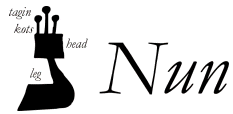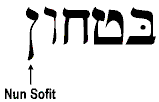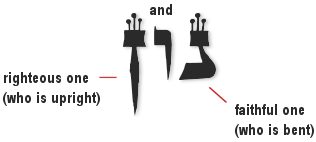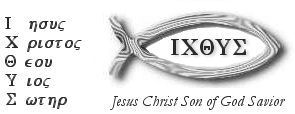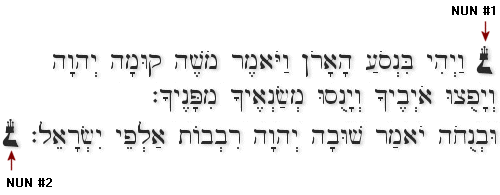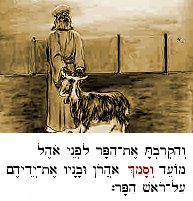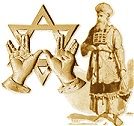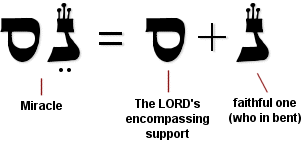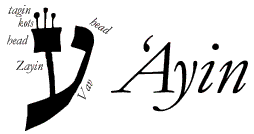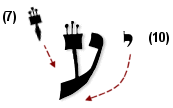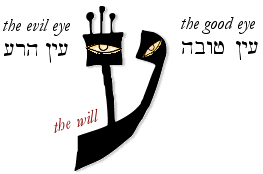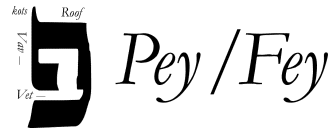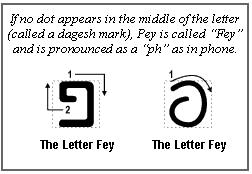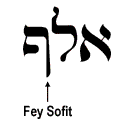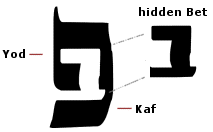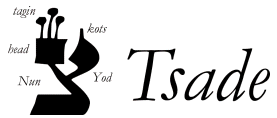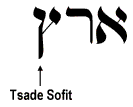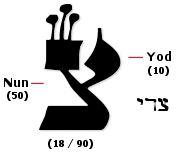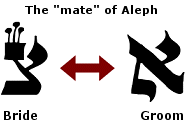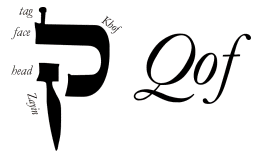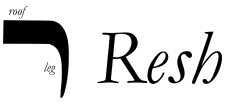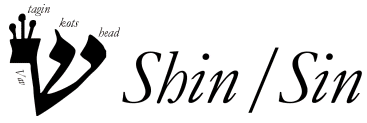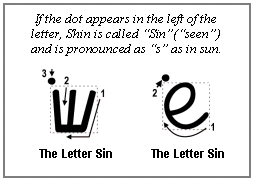|
The letter Yod is the 10th letter of the Aleph-Bet, having the numeric value of 10. The pictograph for Yod looks like an arm or hand, whereas the classical Hebrew script is constructed of a single tag upward, a kotz downward, and a middle portion. Yod is the most frequently occurring letter in the Scriptures as well as the smallest of the letters.
- The Mystery of Yod
Suspended in mid-air, Yod is the smallest of the Hebrew letters, the "atom" of the consonants, and the form from which all of the other letters begin and end:
The first dot with which the scribes first start writing a letter, or the last dot that gives a letter its final form -- is a yod. (Likutei Maharan)
In the Jewish mystical tradition, Yod represents a mere dot, a divine point of energy. Since Yod is used to form all the other letters, and since God uses the letters as the building blocks of creation, Yod indicates God's omnipresence.
In fact, the word יוֹד (yod) itself depicts something of the geometry of creation. It begins with the Yod itself, as a dot, and then moves downward, from the divine toward the created order to form Vav (the "hook" of creation). Finally it moves outward in the horizontal realm as Dalet (the "doorway" of creation). This can better be seen with the following illustration:
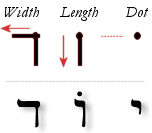
Since Yeshua upholds the world by the Word of His power (Hebrews 1:3), and Yod is part of every Hebrew letter (and therefore every word), Yod is considered the starting point of the presence of God in all things - the "spark" of the Spirit in everything.
- Yod and Humility
The letter Yod, being the smallest of the letters, is also a picture of humility. For example, when Jacob was renamed from Ya'akov to Yisrael, all that remained of his former name was the letter Yod.

Yod can also be seen as a mark of humility in the text that says Moses was "the most humble man" upon the face of the earth (Numbers 12:3):

The Jewish scribes say that an extra Yod is inserted in the word ana (meaning humble or meek) to emphasize the humility of Moses.
Israel is likewise called the "smallest of the nations" (Deuteronomy 7:7) and is consider a type of Yod before the great nations of the earth:

"for you are the smallest of the peoples."
- The "Kots of a Yod"
Because of its humility, Yod is adorned with a small ascending prong (tag) that points to God. The "kotz of a Yod" is the small serif at the bottom of the "face" of the Yod's head and is the smallest of all markings made in the Hebrew text. This most likely refers to the "tittle" Yeshua spoke of in Matthew 5:18 and Luke 16:17. In the Jewish scribal arts known as Soferut, a Torah Scroll is invalid (possul) if it lacks even this serif of the Yod (Menachot 29a):

Even though it is small, Yod is vital, since without the "kotz of a Yod" the entire Torah is to be considered invalid. God delights in using the small, the weak, and the insignificant to demonstrate His glory and power. If you are brought low or of little stature in this world, you can trust that your life is important to God. Since every letter of the Torah is important, and no two letters are the same (or can be "touching" or "malformed") you can trust that your life is significant in the Great Torah of the universe -- that is, in God's great plan that works "all things together for good to those who love Him."
- The Three Parts of Yod
The letter Yod is said to be composed of three parts: the upper prong (tag), a lower line curved downward, and a middle section. The upper tag points toward God, the lower line points toward earth, and the middle section holds the parts together in unity. Therefore, since it is three parts in one, Yod is not unlike the letter Aleph in alluding to divinity and picture Yeshua as our humble Mediator before the Father.

Note also that the gematria of the word "Aleph" equals the Sacred Name  , which also begins with the letter Yod. , which also begins with the letter Yod.
- Yod and Spirituality
Yod means "arm" or "hand," and its form suggests a hand that is reaching toward heaven. In addition, the letter somewhat resembles a man in prayer:
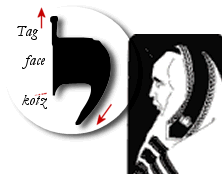
Here the tag suggests a crown that is given to one who is humbled before the LORD in prayer, and the bent shape suggests submission.
Interestingly, the gematria of the word "Yod" is 20 (י+וֹ+ד), the same value for the Hebrew root for vision, chazah (חָזָה).
- The Meaning of Yod as Ten
The word יוֹד (yod) means "arm" or "hand" and the numeric value is ten. Now ten is a number marking shelemut, or completion and order, as evidenced by the following:
- The base 10 number system is universal. Just as Yod is part of all of the previous letters of the alphabet (as a component), so Yod is part of all of the numbers. It is said by the sages the Yod does not mean 10 because we have ten toes and fingers but we have ten toes and fingers because Yod means 10.
- There were ten things created on the first day and ten things created at the end of the sixth day of creation.
- There were ten generations from Adam to Noah, suggesting that the godlessness of those generations was made complete.
- There were ten generations from Noah to Abraham, suggesting that the godliness of those generations was made complete.
- According to midrash, there were ten trials given to Abraham to demonstrate his merit as the father of the nations.
- There were ten plagues issued during the Exodus of Egypt.
- God gave us Ten Commandments.
- The "tenth part" shall be holy for the LORD (Leviticus 27:32).
- There are ten days of Awe - from Tishri 1 to Tishri 10, culminating in Yom Kippur, which occurs on the 10th day of Tishri.
- Ten men are required for a minyan, or complete quorum needed for Jewish corporate prayer.
- (Jewish mysticism) There are ten forces of the "Tree of Life," called Sefirot, that depict the metaphysical working of God in the universe.
- Yod and the Olam Habah
The Talmud states that God used the letter Hey to create the present world (olam hazeh) and Yod to create the world to come (olam habah). The sages derive this idea from the Name yah (יָהּ) found in Isaiah 26:4:

How did they come up with this? Well, they consider b'yah in the text as meaning "with Yod-Hey" instead of referring to the Name Yah.
- Some Textual Oddities
An undersized Yod appears in Deuteronomy 32:17:

"You neglected the Rock who begat you." The LORD is made "small" when we turn away from Him through neglect.
On the other hand, an oversized Yod appears in Numbers 14:17:

"Let the power of my LORD be great." Here Moses' intercession for the people of Israel is made, and the sages say that the oversized Yod is meant to recall the ten trials of Abraham and the merit he obtained on account of his faith.
Finally, a Yod is missing in Exodus 32:19:

"...Moses cast the tables from his hands." Here the spelling in the text (ketiv) is miyado, meaning "from his hand" (singular), but the text is read (Qere) as miyadav, meaning "from his hands" (plural). Why is this singular spelling used yet the text read as plural?
According to midrash, when Moses brought the Tablets of the Law down from Mount Sinai, he was able to carry them in one hand (as the text says in Exodus 32:15) since they were made supernaturally light as the "Living Torah" of the LORD. However, once the Tablets came into proximity with the Golden Calf, the "script flew off and ascended to heaven" to testify of the idol worship (Targum Yonasan) and tablets turned into normal, profane stone which Moses could no longer bear.
- Yod and the Divine Name
Yod is the first letter of the Divine Name YHVH (יהוה) and the name of the Savior of the world, Yeshua (יֵשׁוּעַ), thus indicating its preeminence. It is also the first letter for the four names given to the Jewish people:
- יַעֲקב - Ya'akov (or Jacob)
- יִשְׂרָאֵל - Yisrael (Israel)
- יְהוּדִים - Yehudim (Jews)
- יְשֻׁרוּן - Yeshurun (Jeshurun)
As the first letter (ot, or sign) of God's Name, Yod shows that He is Spirit, He is One, and that from Him derive all other things by the power of His Word.
|


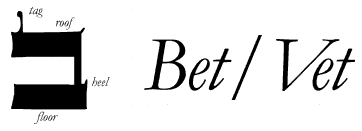




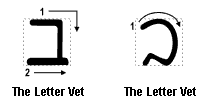


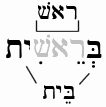






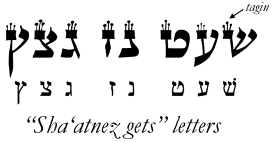
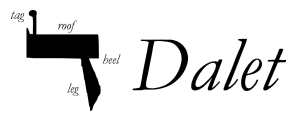





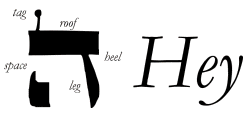







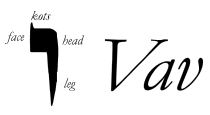





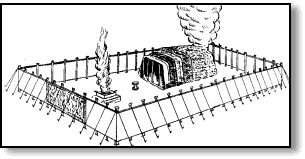
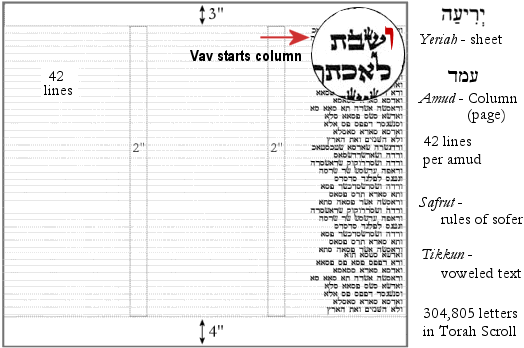

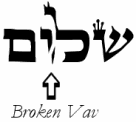
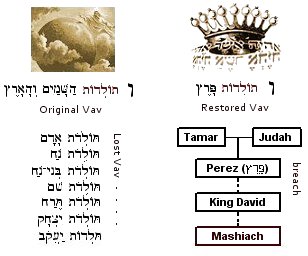

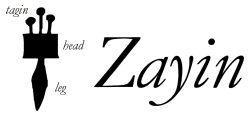










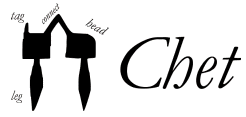







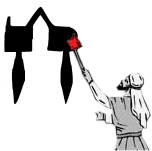

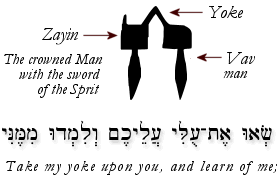
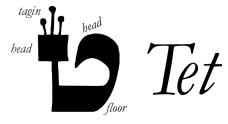










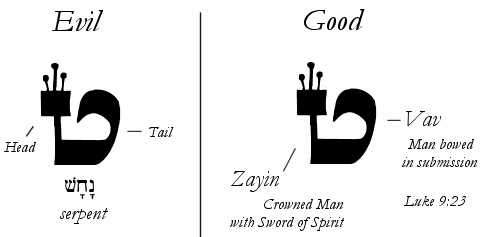


















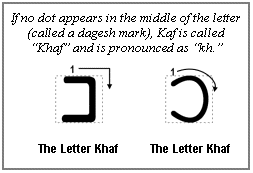





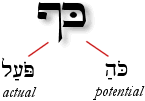



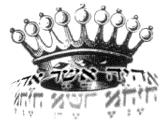



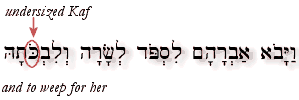
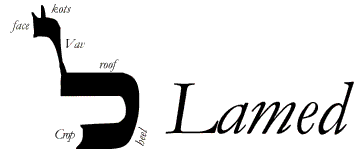





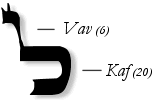






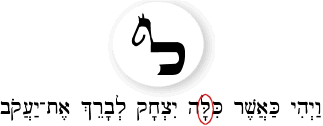
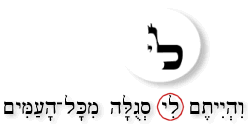

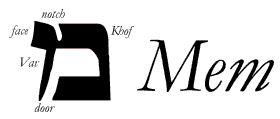





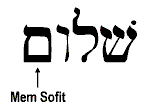




![Proverbs 9:6[7h] (BHS)](http://www.hebrew4christians.com/Grammar/Unit_One/Aleph-Bet/Mem/isaiah9-7closedmem.gif)
![Proverbs 9:6[7h] (BHS)](http://www.hebrew4christians.com/Grammar/Unit_One/Aleph-Bet/Mem/isa9-6.gif)
![Proverbs 9:7[8h] (BHS)](http://www.hebrew4christians.com/Grammar/Unit_One/Aleph-Bet/Mem/isa9-7.gif)



